
Deutsch-Chinesische Enzyklopädie, 德汉百科

 Belgium
Belgium
 Denmark
Denmark
 Germany
Germany
 Estonia
Estonia
 Finland
Finland
 France
France

 History
History
 M 1500 - 2000 AD
M 1500 - 2000 AD

 History
History

 History
History
 N 2000 - 2100 AD
N 2000 - 2100 AD
 Greece
Greece

 Ile-de-France
Ile-de-France
 Ireland
Ireland
 Italy
Italy



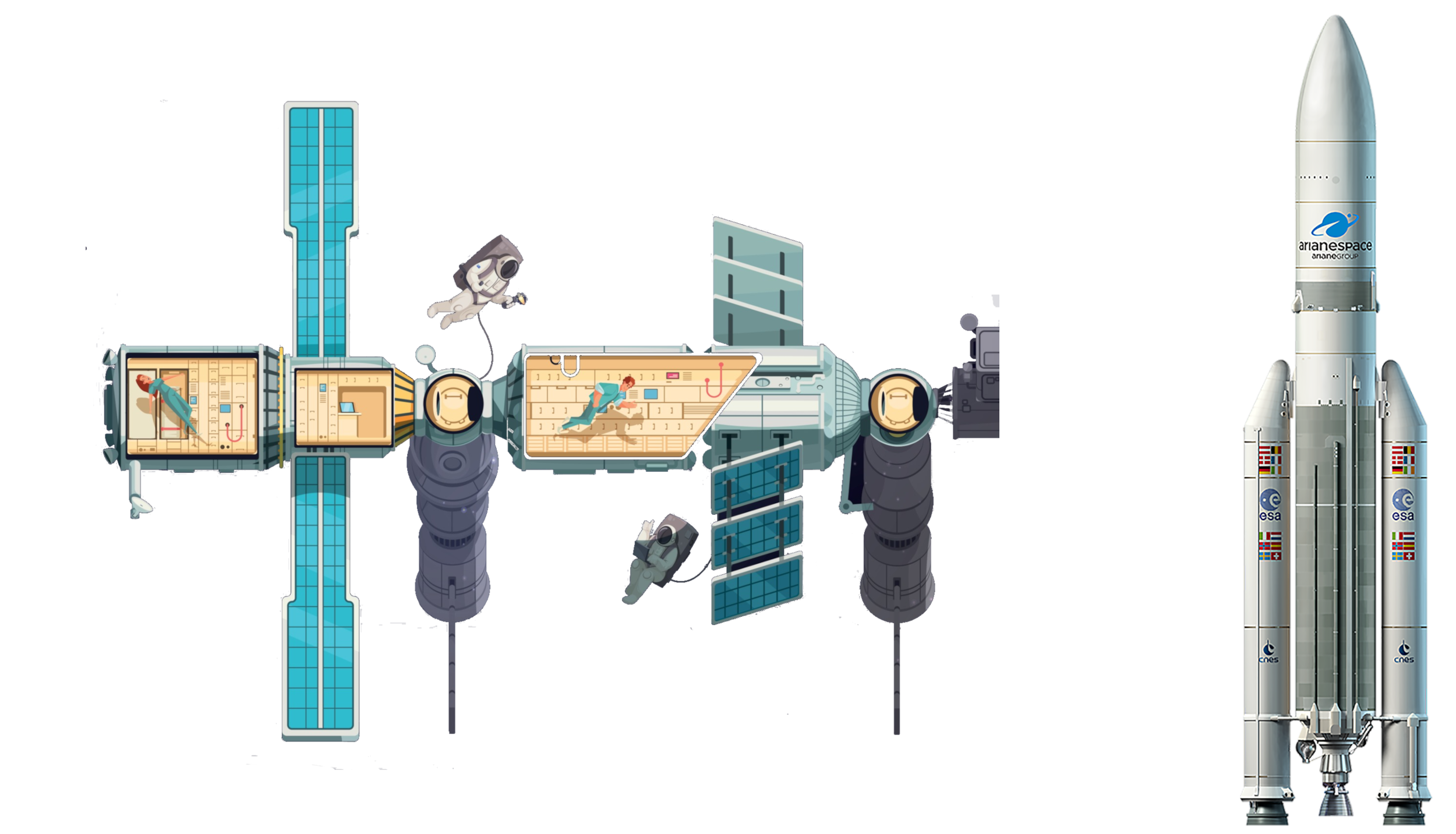 Aerospace
Aerospace
 *ASI
*ASI



 Aerospace
Aerospace
 *CNES
*CNES



 Aerospace
Aerospace
 *DLR
*DLR



 Aerospace
Aerospace
 *NASA
*NASA



 Aerospace
Aerospace
 Missions to Mars
Missions to Mars



 Aerospace
Aerospace
 Artemis program
Artemis program
 Luxembourg
Luxembourg
 Netherlands
Netherlands
 Norwegen
Norwegen
 Austria
Austria
 Poland
Poland
 Portugal
Portugal
 Romania
Romania
 Sweden
Sweden
 Switzerland
Switzerland
 Spain
Spain
 Czech Republic
Czech Republic
 Hungary
Hungary
 United Kingdom
United Kingdom

 Science and technology
Science and technology
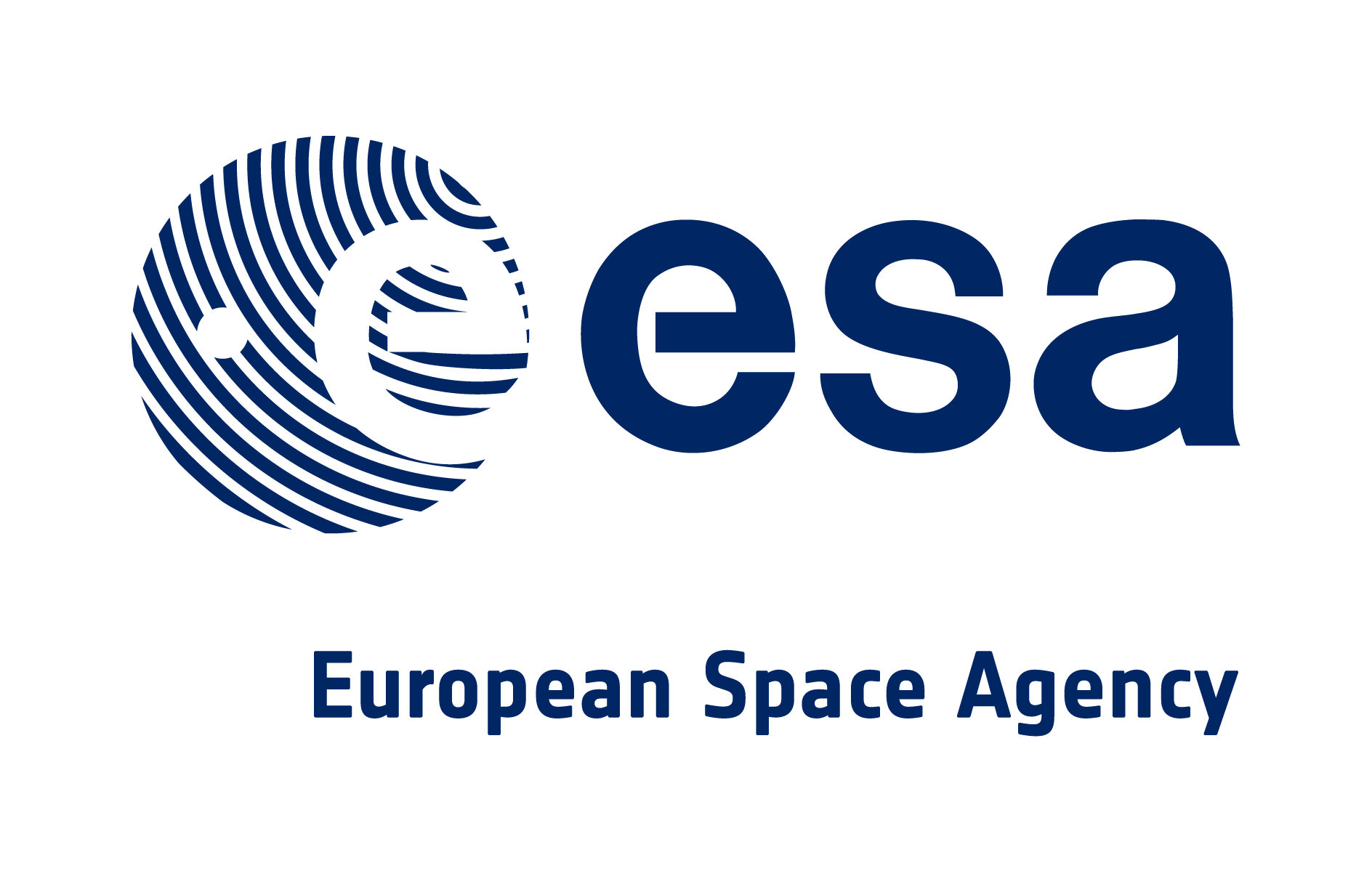
欧空局有14个成员国:奥地利、比利时、丹麦、芬兰、法国、德国、爱尔兰、意大利、荷兰、挪威、西班牙、瑞典、瑞士、大不列颠及北爱尔兰联合王国。加拿大与欧空局订有一个密切合作的协定。
欧空局由各成员国代表组成的理事会领导,行政首长是总干事。欧空局1997年预算约为30亿埃居(35亿美元)。雇用的工作人员约为1,750人。
成员国必须参加强制性的科学和基础技术方案,但自行决定对地球观测、电信、空间运输系统、空间站和微重力方面的各个任选方案的贡献。
欧空局有下列机构:
(a)设在巴黎的总部,政治决定在此作出;
(b)设在荷兰诺德韦克的欧洲航天研究和技术中心,它是欧空局的主要技术机构,大多数项目小组以及空间科学部和技术研究和支助工程师在此工作。欧洲航天研究和技术中心还提供有关的试验设施;
(c)设在德国达姆施塔特的欧洲航天空间操作中心,它负责所有卫星操作以及相应的地面设施和通信网络;
(d)设在意大利弗拉斯卡蒂的欧洲航天研究所,它的主要任务是利用来自空间的地球观测数据;
(e)设在德国porz-Wahn的欧洲航天员中心,它协调所有欧洲航天员活动,包括未来欧洲航天员的培训。
欧空局还对设在库鲁的欧洲航天港圭亚那航天中心作出贡献。(Quelle:http://www.cnsa.gov.cn/n615708/n620174/n620669/n888645/67008.html)
欧洲空间局(法语:Agence spatiale européenne,缩写:ASE; 英语:European Space Agency,缩写:ESA)是由欧洲数国政府组成的的国际空间探测和开发组织,总部设在法国首都巴黎。欧洲空间局负责阿丽亚娜4号和阿丽亚娜5号火箭运载火箭的研制与开发。
欧洲空间局的前身,欧洲航天研究组织(European Space Research Organization,ESRO)经过1962年6月14日签署的一项协议,于1964年3月20日建立。如今它仍旧是ESA的一部分,称为欧洲空间研究与技术中心,位于荷兰诺德韦克。
ESA目前共有19个成员国:奥地利、比利时、捷克、丹麦、芬兰、法国、德国、希腊、爱尔兰、意大利、卢森堡、荷兰、挪威、葡萄牙、西班牙、瑞典、瑞士、罗马尼亚以及英国;另外,加拿大是ESA的准成员国(Associate Member)。法国是其主要贡献者(参见法国国家空间研究中心)。目前,ESA与欧盟没有关系。欧盟辖下另有欧盟卫星中心(European Union Satellite Centre)。
ESA共有约2200名工作人员。其2011年的预算约为40亿欧元。
ESA的航天发射中心位于南美洲北部大西洋海岸的法属圭亚那,占地约90600平方公里,属法国国家空间研究中心领导,主要负责科学卫星、应用卫星和探空火箭的发射以及与此有关的一些运载火箭的试验和发射。由于此地靠近赤道, 对火箭发射具有很大益处:纬度低,从发射点到入轨点的航程大大缩短,三子级不必二次启动;相同发射方位角的轨道倾角小,远地点变轨所需要的能量小,增加了 同步轨道的有效载荷;向北和向东的海面上有一个很宽的发射弧度;人口、交通、气象条件理想等。目前,航天中心有阿里安第一、第二、第三发射场,是欧洲航天 活动的主要基地。控制中心则位于德国的达姆施塔特。
Die Europäische Weltraumorganisation, englisch European Space Agency (ESA), französisch Agence spatiale européenne (ASE), ist eine internationale Weltraumorganisation mit Sitz in Paris. Sie wurde am 30. Mai 1975 mit dem Übereinkommen zur Gründung einer Europäischen Weltraumorganisation mit Unterzeichnung unter das Abkommen durch die zunächst noch neun ursprünglichen Gründungsmitglieder in Paris gegründet.[3] Nach Hinterlegung der letzten Ratifikationsurkunde durch Frankreich trat am 30. Oktober 1980 gemäß Artikel XXI Absatz 1 des Übereinkommens die Gründung dann in Kraft.[3][4][5]
Die Gründung bezweckte eine bessere Koordinierung der europäischen Raumfahrtaktivitäten, um technologisch gegenüber den Raumfahrtnationen Sowjetunion und Vereinigte Staaten gleichberechtigt auftreten zu können. Sie hat 22 Mitgliedstaaten und beschäftigte 2017 etwa 2200 Mitarbeiter.[6]
Die ESA ist die Nachfolgeorganisation der europäischen ELDO, ESRO und der Europäischen Fernmeldesatelliten-Konferenz (CETS). Wie diese beschränkt sie sich gem. Art. II ihres Statuts in ihren europäischen Projekten zur Weltraumerforschung und -nutzung auf „ausschließlich friedliche Zwecke“.
Die Mehrzahl der EU-Staaten ist an der ESA beteiligt. Daneben engagieren sich dort auch die Schweiz und Norwegen. Die ESA kooperiert zunehmend mit der EU[7] sowie den nationalen Raumfahrtagenturen insbesondere Deutschlands und Frankreichs.[8]
Die ESA ist gemeinsam mit der NASA Gründungsmitglied des Consultative Committee for Space Data Systems (CCSDS).
欧州宇宙機関(おうしゅううちゅうきかん、仏: Agence spatiale européenne[1], ASE、英: European Space Agency, ESA)は、1975年5月30日にヨーロッパ各国が共同で設立した、宇宙開発・研究機関である。設立参加国は当初10か国、現在は19か国が参加し、2000人を超えるスタッフがいる。
本部はフランスに置かれ、その活動でもフランス国立宇宙センター (CNES) が重要な役割を果たし、ドイツ・イタリアがそれに次ぐ地位を占める。主な射場としてフランス領ギアナのギアナ宇宙センターを用いている。
人工衛星打上げロケットのアリアンシリーズを開発し、アリアンスペース社(商用打上げを実施)を通じて世界の民間衛星打ち上げ実績を述ばしている。2010年には契約残数ベースで過去に宇宙開発などで存在感を放ったソビエト連邦の後継国のロシア、スペースシャトル、デルタ、アトラスといった有力な打ち上げ手段を持つアメリカに匹敵するシェアを占めるにおよび[2]、2014年には受注数ベースで60%のシェアを占めるにいたった[3][4]。
ESA は欧州連合と密接な協力関係を有しているが、欧州連合の専門機関ではない。加盟各国の主権を制限する超国家機関ではなく、加盟国の裁量が大きい政府間機構として形成された。リスボン条約によって修正された欧州連合の機能に関する条約の第189条第3項では、「欧州連合は欧州宇宙機関とのあいだにあらゆる適切な関係を築く」と規定されている。
The European Space Agency (ESA; French: Agence spatiale européenne, ASE;[4][5] German: Europäische Weltraumorganisation) is an intergovernmental organisation of 22 member states[6] dedicated to the exploration of space. Established in 1975 and headquartered in Paris, France, ESA has a worldwide staff of about 2,000[7] and an annual budget of about €5.25 billion / US$5.77 billion (2016).[8]
ESA's space flight programme includes human spaceflight (mainly through participation in the International Space Station program); the launch and operation of unmanned exploration missions to other planets and the Moon; Earth observation, science and telecommunication; designing launch vehicles; and maintaining a major spaceport, the Guiana Space Centre at Kourou, French Guiana. The main European launch vehicle Ariane 5 is operated through Arianespace with ESA sharing in the costs of launching and further developing this launch vehicle. The agency is also working with NASA to manufacture the Orion Spacecraft service module, that will fly on the Space Launch System.[9][10]
The agency's facilities are distributed among the following centres:
- ESA science missions are based at ESTEC in Noordwijk, Netherlands;
- Earth Observation missions at ESA Centre for Earth Observation in Frascati, Italy;
- ESA Mission Control (ESOC) is in Darmstadt, Germany;
- the European Astronaut Centre (EAC) that trains astronauts for future missions is situated in Cologne, Germany;
- a research institute created in 2009, the European Centre for Space Applications and Telecommunications (ECSAT), is at Harwell, England;
- and the European Space Astronomy Centre (ESAC) is located in Villanueva de la Cañada, Madrid, Spain.
L’Agence Spatiale Européenne (ASE ; en anglais : European Space Agency et en allemand : Europäische Weltraumorganisation), le plus souvent désignée par son sigle anglophone ESA, est une agence spatiale intergouvernementale coordonnant les projets spatiaux menés en commun par une vingtaine de pays européens. L'agence spatiale, qui par son budget (5 750 millions d'euros en 2017) est la troisième agence spatiale dans le monde après la NASA et l'agence spatiale fédérale russe, a été fondée le 31 mai 1975. Les activités de l'agence couvrent l'ensemble du domaine spatial : les sciences avec l'astrophysique, l'exploration du Système solaire, l'étude du Soleil et la physique fondamentale ; l'étude et l'observation de la Terre avec des satellites spécialisés ; le développement de lanceurs ; les vols habités à travers sa participation à la Station spatiale internationale et à Orion ; la navigation par satellite avec le programme Galileo ; les télécommunications spatiales pour lesquelles l'agence finance la mise au point de nouveaux concepts ; la recherche dans le domaine des technologies spatiales. L'ESA participe également à des programmes spatiaux initiés par d'autres agences spatiales.
La stratégie est définie par un conseil dans lequel chaque pays membre dispose d'un représentant. Les programmes initiés par l'agence, qui représentent 75 % du budget, sont financés directement par les pays membres. Ceux-ci versent une contribution proportionnelle à leur PIB pour le financement de 20 % du budget (programme scientifique et frais généraux) et participent dans des proportions de leur choix aux programmes facultatifs. Le quart du budget est fourni par l'Union européenne et EUMETSAT pour le développement du segment spatial de ces programmes gérés par ces institutions (programme Galileo, satellites météorologiques, GMES/Copernicus). Certains des pays membres conservent, à côté de leur participation aux programmes européens, des programmes spatiaux purement nationaux.
L'agence spatiale européenne, qui a son siège à Paris, confie après sélection sur appel d'offres les travaux de recherche et le développement des engins spatiaux aux universités, instituts et industriels des pays membres en appliquant le principe du « retour géographique » : les dépenses de l'agence dans chaque pays sont au prorata de la contribution. L'agence emploie environ 2 233 personnes (2016) et dispose de plusieurs établissements spécialisés. Son centre principal est l'ESTEC aux Pays-Bas qui est dédié à la conception et aux tests des engins spatiaux. Les autres centres importants sont l'ESOC en Allemagne (suivi et contrôle des missions en cours) et l'ESTRACK (réseau mondial d'antennes paraboliques, pour assurer la liaison avec les engins spatiaux). L'ESA utilise aussi les installations du centre de lancement de Kourou, établissement du CNES pour le lancement de ses fusées.
L'Agenzia spaziale europea, ufficialmente denominata Agence spatiale européenne (dal francese; in acronimo ASE[2]) o, più frequentemente, European Space Agency (dall'inglese; in acronimo ESA), è un'agenzia internazionale fondata nel 1975 incaricata di coordinare i progetti spaziali di 22 Paesi europei[3]. Il suo quartier generale si trova a Parigi, in Francia[4], con uffici a Mosca, Bruxelles, Washington e Houston. Il personale dell'ESA del 2016 ammontava a 2 200 persone (esclusi sub-appaltatori e le agenzie nazionali) e il budget era di 5,25 miliardi di euro[5]. Attualmente il direttore generale dell'agenzia è Johann-Dietrich Woerner.
Lo spazioporto dell'ESA è il Centre Spatial Guyanais a Kourou,[6] nella Guyana francese, un sito scelto, come tutte le basi di lancio, per via della sua vicinanza con l'equatore. Durante gli ultimi anni il lanciatore Ariane 5 ha consentito all'ESA di raggiungere una posizione di primo piano nei lanci commerciali e l'ESA è il principale concorrente della NASA nell'esplorazione spaziale.
Le missioni scientifiche dell'ESA hanno le loro basi all'ESTEC di Noordwijk, nei Paesi Bassi.[7] Lo European Space Operations Centre (ESOC), di Darmstadt in Germania[8], è responsabile del controllo dei satelliti ESA in orbita. Le responsabilità dello European Space Research Institute (ESRIN) di Frascati, in Italia, includono la raccolta, l'archiviazione e la distribuzione di dati satellitari ai partner dell'ESA; oltre a ciò, la struttura agisce come centro di informazione tecnologica per l'intera agenzia[9]. Lo European Astronaut Centre (EAC) è situato a Colonia, in Germania[10], ed è un centro per la selezione, l'addestramento, il supporto medico degli astronauti, oltre al supporto per le preparazioni al lancio e durante le missioni. Infine lo European Space Astronomy Centre (ESAC), situata a Villanueva de la Cañada[11], è il centro ESA per la ricerca astronomica.
La Agencia Espacial Europea (en inglés: European Space Agency, en francés: Agence spatiale européenne; abreviada ESA por sus siglas inglesas y ASE2 por sus siglas francesas) es una organización internacional dedicada a la exploración espacial, con 22 Estados miembros.3 Fue constituida el 31 de mayo de 1975.4 Emplea a unas 2000 personas (excluyendo subcontratados)56 y tiene un presupuesto anual de 5600 millones de euros para el año 2018.1 La sede principal de la ESA está en París, Francia, aunque las estructuras de la ESA están muy descentralizadas.
Европе́йское косми́ческое аге́нтство (сокращённо ЕКА; англ. European Space Agency, ESA; фр. Agence spatiale européenne, ASE) — международная организация, созданная в 1975 году в целях исследования космоса.
ЕКА состоит из 22 постоянных членов, в некоторых проектах также принимает участие Канада.
Штаб-квартира Агентства находится в Париже. В Нордвейке (Нидерланды) расположен Европейский центр космических исследований и технологий. Европейский космический центр управления расположен в Дармштадте (Германия). В другом германском городе, Кёльне, расположен Европейский центр астронавтов. Центр наблюдения за Землёй и информационный центр Европейского космического агентства находятся во Фраскати под Римом (Италия). Для запусков создаваемых космических аппаратов используется космодром Куру во Французской Гвиане. ЕКА имеет контактные офисы в Бельгии, США и России и наземные станции слежения по всему миру.
В агентстве постоянно работает 1907 человек (2005), а его бюджет составляет более 4 миллиардов евро (2012).

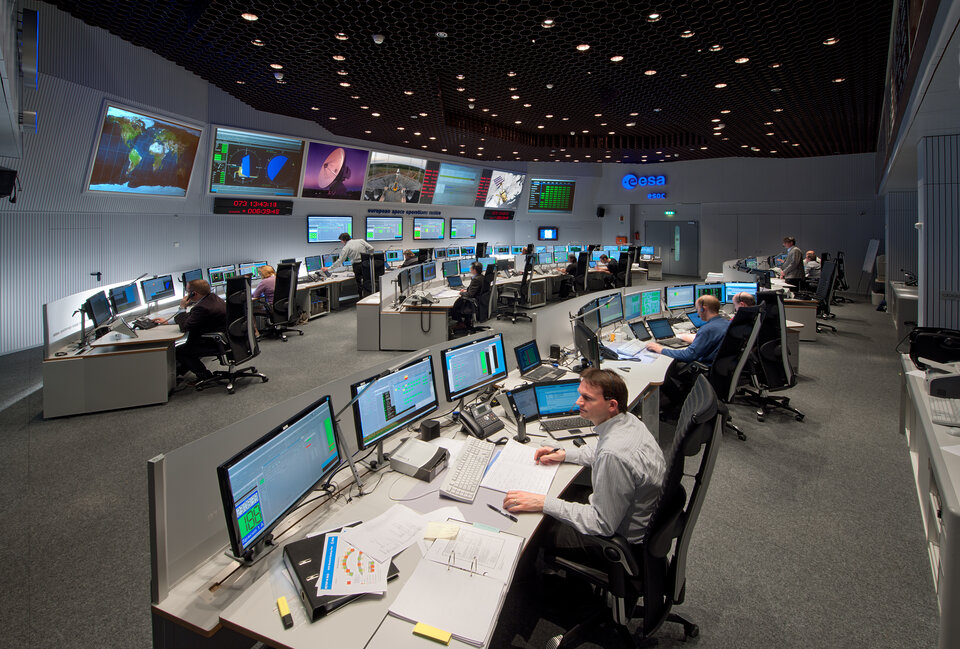
欧洲空间业务中心(英语:European Space Operations Centre)是欧洲空间局(ESA)的主要任务控制中心,位于德国达姆施塔特。欧洲空间业务中心的主要任务是代表欧洲空间局和Launch and Early Orbit Phases(LEOP)操控无人飞船并执行一些第三方任务。[2] 该中心还与欧洲空间局的国际合作伙伴和工厂负责着地面系统的工程、软件开发、飞行动力学和导航、任务控制工具和技术,空间碎片的研究开发合作业务等一系列合作。[3]
欧洲空间业务中心目前的主要任务包括恒星与行星的研究(如火星快车号和罗塞塔号)、天文学和基础物理学(如盖亚任务和XMM-牛顿卫星)和地球观测任务(如CryoSat2和Swarm (spacecraft))。运营中心还负责着ESTRACK网络地面站的开发、运营和维护。Teams at the Centre are also involved in research and development related to advanced mission control concepts and Space Situational Awareness, and standardisation activities related to frequency management; mission operations; tracking, telemetry and telecommanding; and 空间垃圾Das Europäische Raumflugkontrollzentrum (kurz ESOC für englisch European Space Operations Centre) mit Hauptsitz im Europaviertel von Darmstadt (Hessen, Deutschland) ist eines der Operationszentren der Europäischen Weltraumorganisation (ESA). Es wurde am 8. September 1967 vom damaligen Bundesforschungsminister der Bundesrepublik Deutschland, Gerhard Stoltenberg, eröffnet.
Das ESOC ist das Missionskontrollzentrum für die meisten Weltraumprojekte der ESA. Mit seinen 800 Mitarbeitern betreut es ein gutes Dutzend Vorhaben gleichzeitig und verwendet als weltweites Netz von Bahnverfolgungsstationen sowohl ESTRACK als auch das Deep Space Network der NASA. Aufgrund von standardisierten Verfahren kann ESOC weltweit mit allen Anlagen nach CCSDS zusammenarbeiten und ganz oder zeitweise die Kontrolle von Missionen anderer Weltraumorganisationen wie z. B. der ISRO oder der JAXA übernehmen oder deren Missionskontrollzentren mit Daten unterstützen.
Während der Projektplanung empfehlen die Expertenteams geeignete Trägerraketen, Flug- und Umlaufbahnen sowie die Software für die Steuerung. Die zunehmenden Gefahren durch Weltraummüll – die vielen tausend Fragmente von Raumfluggeräten, die die Erde umkreisen – werden ebenfalls von ESA/ESOC überwacht. Das Space Debris Office betreibt dafür eine international genutzte Datenbank. Das Zentrum beherbergt zudem das Team des neuen ESA-Programms zur „Weltraumlageerfassung“ (Space Situational Awareness Programme).
欧州宇宙運用センター(おうしゅううちゅううんようセンター、英語: European Space Operations Centre、ESOC)は、欧州宇宙機関(ESA)の衛星と宇宙探査機の運用を行っている機関。ドイツのダルムシュタットに所在。ESAの宇宙計画の多くのミッションコントロールがここで行われている。設立は1967年で、60以上の欧州の宇宙計画を執り行っている。また、ESOCは地上局とアンテナのESTRACKネットワークの遠隔運用を行っている地上施設コントロールセンター(Ground Facilities Control Centre、GFCC)も収容している。
現在、ESOCはXMM-Newton、クラスター2、Envisat、インテグラル、マーズ・エクスプレス、ロゼッタ、ビーナス・エクスプレス、GOCE、ハーシェル宇宙望遠鏡、プランク、CryoSatを運用し、その他近年ではスマート1、カッシーニ、ERS-2などが運用されていた。
また、LISA パスファインダー、ADM-Aeolus、SWARM、センチネル、ガイア計画などが準備中である。MetOp-AなどはLEOPの運用のみを行い、その後は欧州気象衛星開発機構に引き渡している。
また、監視・制御などさまざまに適応できるソフトウェア基盤(SCOS 2000)など現在や将来の計画の支援に必要とされる技術基盤の開発を行っている
宇宙科学データの処理には宇宙機からの信号の受信が可能な追跡・通信用地上局のネットワークの設置と、追跡ネットワークからの情報を編集・処理する中央施設の2種の技術が必要とされる。
欧州の地上基地ネットワークはベルギーのルデュ、アラスカのフェアバンクス、ノルウェーのスヴァールバル諸島、イギリス領のフォークランド諸島の4箇所の地上局から構成されている。欧州宇宙運用センターはこれらを統括する中央施設になっている。
The European Space Operations Centre (ESOC) serves as the main mission control centre for the European Space Agency (ESA) and is located in Darmstadt, Germany. ESOC's primary function is the operation of unmanned spacecraft on behalf of ESA and the launch and early orbit phases (LEOP) of ESA and third-party missions.[2] The Centre is also responsible for a range of operations-related activities within ESA and in cooperation with ESA's industry and international partners, including ground systems engineering, software development, flight dynamics and navigation, development of mission control tools and techniques and space debris studies.[3]
ESOC's current major activities comprise operating planetary and solar missions, such as Mars Express and the Trace Gas Orbiter, astronomy & fundamental physics missions, such as Gaia (spacecraft) and XMM Newton, and Earth observation missions such as CryoSat2 and Swarm (spacecraft).
ESOC is responsible for developing, operating and maintaining ESA's ESTRACK network of ground stations. Teams at the Centre are also involved in research and development related to advanced mission control concepts and Space Situational Awareness, and standardisation activities related to frequency management; mission operations; tracking, telemetry and telecommanding; and space debris.[4]
Le Centre européen des opérations spatiales (en anglais : European Space Operations Centre : ESOC), situé à Darmstadt en Allemagne, est chargé du suivi de toutes les sondes spatiales qui sont sous le contrôle total de l'Agence spatiale européenne (ESA). Le Centre a pris de plus en plus d'importance depuis l'an 2000, avec l'augmentation du nombre de missions spatiales européennes.
Pendant le déroulement des missions, l'ESOC propose des corrections de trajectoires ; il surveille également les trajectoires de milliers de débris de véhicules spatiaux orbitant autour de la Terre, et permet de prévoir les dangers de collisions.
Il Centro europeo per le operazioni spaziali (ESOC, dall'inglese European Space Operations Centre) è un centro spaziale che gestisce le operazioni di controllo dei satelliti dell'Agenzia Spaziale Europea (ESA). Si trova a Darmstadt, in Germania.
Il controllo dei satelliti, dal momento del loro lancio e per tutta la durata della loro missione in orbita, viene gestito centralmente dall'ESOC utilizzando stazioni di controllo sparse in tutto il mondo, che ricevono telemetria dai satelliti e trasmettono i comandi di posizionamento e di attivazione delle apparecchiature di bordo. L'ESOC riceve ed elabora, o ritrasmette ad altri centri per l'elaborazione, i dati provenienti dalle stazioni di controllo a terra provenienti a loro volta dai veicoli spaziali in orbita (dati scientifici, informazioni meteorologiche, immagini della Terra).
La rete base dei terminali di terra è rappresentata dalla rete di antenne ESTRACK (12 antenne in 8 paesi differenti). Il personale del centro, che conta all'incirca 800 addetti, tra staff permanenti e consulenti è inoltre impiegato nell'evoluzione di progetti per il segmento terrestre dei diversi programmi dell'ESA, tra cui il sistema di posizionamento Galileo e SSA.
Gli ultimi progetti importanti seguiti dal centro sono: Lisa Pathfinder, Mars Express, Rosetta, Huygens, Venus Express, SMART-1, GOCE e Cryosat 2.
El Centro Europeo de Operaciones Espaciales (ESOC por sus siglas en inglés, que vienen de: "European Space Operations Centre") es el encargado del control de los satélites y de las sondas espaciales de la Agencia Espacial Europea (ESA). Está situado en la Robert-Bosch-Strasse en Darmstadt, Alemania.
Es el centro de control de la mayoría de los proyectos espaciales de la ESA, aunque en el centro también se encuentra el Centro de Control de Instalaciones Terrestres (GFCC, "Ground Facilities Control Centre" en inglés), responsable del control remoto de la red de antenas y estaciones en tierra ESTRACK.
Европейский центр управления космическими полётами (англ. European Space Operations Centre, ESOC) — научно-исследовательское подразделение Европейского космического агентства, отвечающее за управление спутниками и космическими зондами. Штаб-квартира ESOC расположена в Дармштадте, Германия. Помимо управления большинством космических проектов ЕКА, в ESOC осуществляется контроль над наземными опорными центрами сети ESTRACK[2].


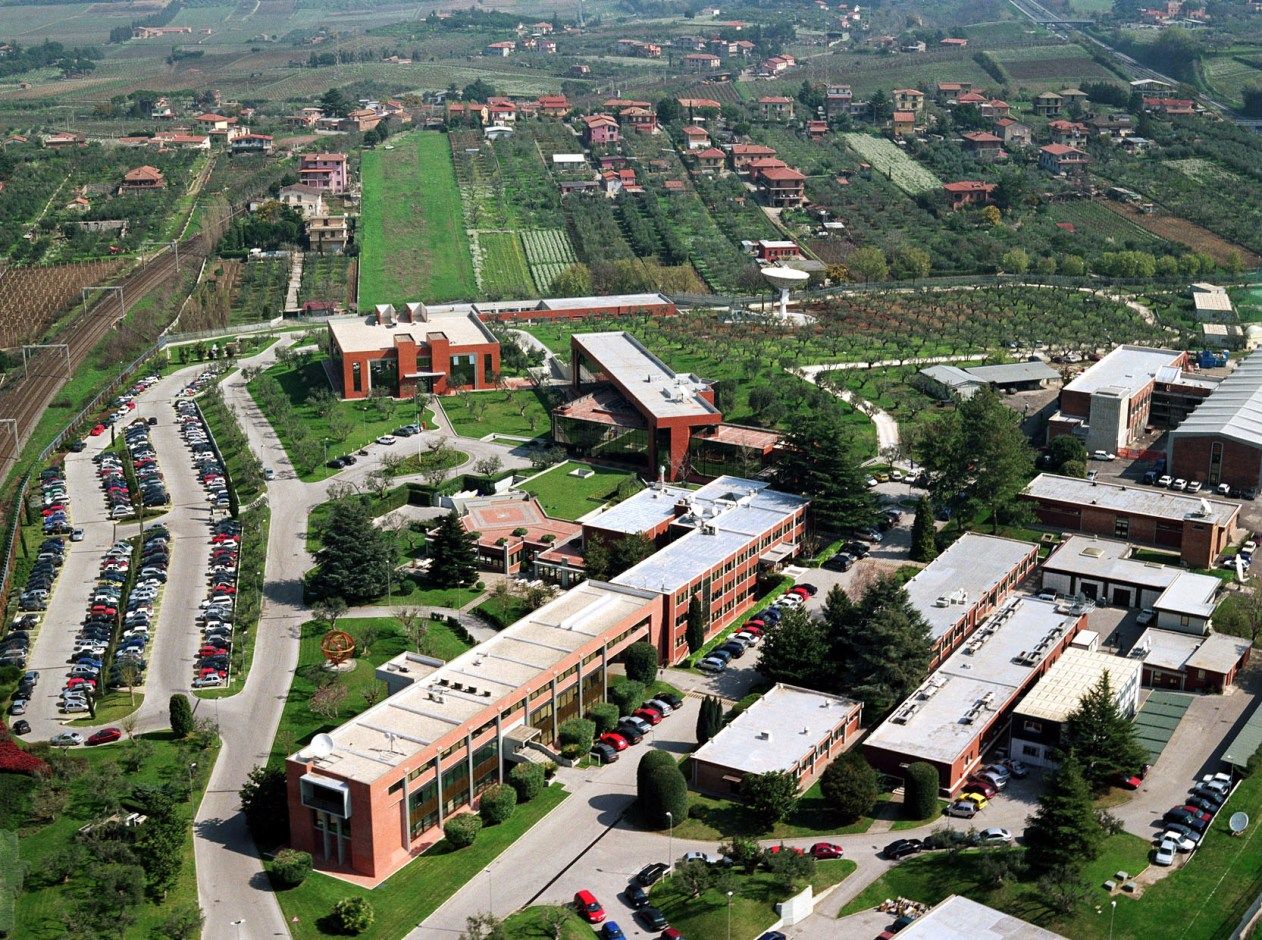


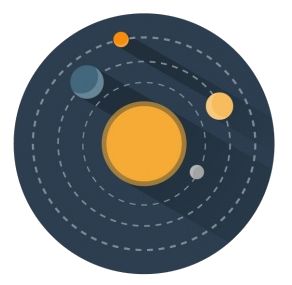 Astronomy
Astronomy



 Automobile
Automobile
 *Self-driving car
*Self-driving car
 Belgium
Belgium
 Denmark
Denmark
 Germany
Germany

 European Union
European Union
 Finland
Finland
 France
France
 Greece
Greece
 Ireland
Ireland


 IT-Times
IT-Times
 Italy
Italy

 Agriculture, forestry, livestock, fishing
Agriculture, forestry, livestock, fishing



 Aerospace
Aerospace
 *DLR
*DLR



 Aerospace
Aerospace
 *ESA
*ESA



 Aerospace
Aerospace
 *CNES
*CNES



 Aerospace
Aerospace
 *ASI
*ASI
 Luxembourg
Luxembourg

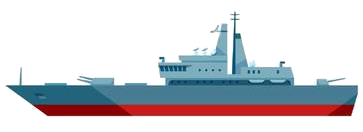


 Military, defense and equipment
Military, defense and equipment
 Navigation Satellite System
Navigation Satellite System
 Netherlands
Netherlands
 Norwegen
Norwegen
 Austria
Austria
 Portugal
Portugal
 Romania
Romania

 Ships and Nautics
Ships and Nautics
 Sweden
Sweden
 Spain
Spain

 Transport and traffic
Transport and traffic
 Czech Republic
Czech Republic
 United Kingdom
United Kingdom

 Science and technology
Science and technology
伽利略定位系统(意大利语:Galileo),是一个正在建造中的卫星定位系统,该系统由欧盟通过欧洲空间局和欧洲导航卫星系统管理局建造[3],总部设在捷克共和国的布拉格。该系统有两个地面操控站,分别位于德国慕尼黑附近的奥伯法芬霍芬和意大利的富齐诺。这个造价五十亿欧元[4]的项目是以意大利天文学家伽利略的名字命名的。伽利略系统的目的之一是为欧盟国家提供一个自主的高精度定位系统,该系统独立于俄罗斯的格洛纳斯系统和美国的全球定位系统(GPS),在这些系统被关闭时,欧盟就可以使用伽利略系统。该系统的基本服务(低精度)是提供给所有用户免费使用的,高精度定位服务仅提供给付费用户使用。伽利略系统的目标是在水平和垂直方向提供精度1米以内的定位服务,并且在高纬度地区提供比其他系统更好的定位服务。[5]
伽利略系统是中地球轨道搜救卫星系统的一部分,可提供一种新的全球搜救方式。伽利略系统的卫星安装有转发器,可以把求救信号从事故地点发送到救援协调中心,救援协调中心就会开始组织救援。同时,该系统还会发射一个返回信号到事故地点处,通知求救人员他们的信号已被收到,相应的救援也正在展开。现有的全球卫星搜救系统是不具备反馈信号功能的,所以伽利略系统这个发消息功能被认为是对全球卫星搜救系统的一个重要升级。[6]2014年,研究人员对伽利略系统的搜救功能进行了测试,该系统是作为当时的全球卫星搜救系统的一部分工作的,测试结果显示,该系统对77%的模拟求救位置定位精度在2千米以内,95%的求救位置定位精度在5千米以内。[7]
伽利略系统的第一颗试验卫星GIOVE-A于2005年12月28日发射,第一颗正式卫星于2011年8月21日发射。该系统计划发射30颗卫星,截止2016年5月,已有14颗卫星发射入轨。伽利略系统于2016年12月15日在布鲁塞尔举行激活仪式,提供早期服务。于2017年到2018年提供初步工作服务,最终于2019年具备完全工作能力。[8] 该系统的30颗卫星预计将于2020年前发射完成,其中包含24颗工作卫星和6颗备用卫星。[9]
Galileo ist ein im Aufbau befindliches, teilweise bereits operationelles, europäisches globales Satellitennavigations- und Zeitgebungssystem unter ziviler Kontrolle (europäisches GNSS).[1]
Es liefert weltweit Daten zur genauen Positionsbestimmung und ähnelt dem US-amerikanischen NAVSTAR-GPS, dem russischen GLONASS-System und dem chinesischen Beidou-System. Die Systeme unterscheiden sich hauptsächlich durch die Frequenznutzungs-/Modulationskonzepte, die Art und Anzahl der angebotenen Dienste und die Art der Kontrolle (GLONASS, Beidou und GPS sind militärisch kontrolliert).
Auftraggeber von Galileo ist die Europäische Union. Der Sitz der Agentur für das Europäische GNSS (Galileo-Agentur, GSA) befindet sich seit 2014 in der tschechischen Hauptstadt Prag.[2]
Mit Stand Ende 2017 sind 22 der vorgesehenen 30 Satelliten in ihrem Orbit.[3] Bis Ende 2019 sollen alle Satelliten in ihre Umlaufbahn gebracht werden. Das Satellitennavigationssystem ist für die Allgemeinheit seit dem 15. Dezember 2016 zugänglich.[4][5]
ガリレオ(Galileo)は、EUが構築した全地球航法衛星システム。
ガリレオはEUによる全地球航法衛星システムである。高度約24000kmの上空に30機の航法衛星を運用することを予定している。民間主体としては初の衛星航法システムであり、EUはアメリカ国防総省が運営するGPSのように、軍事上の理由によるサービスの劣化及び中断を避けられる利点があるとコメントしている。さらに、測位にかかる時間が短縮され、GPSの数メートルに比べて1メートルまで精度を向上できる。
試験衛星は2005年12月28日に1機目のGIOVE-A衛星が打ち上げられ、2006年1月12日から試験電波が発射されており、2007年5月2日に英Surrey Satellite Technologyによって作成された航法メッセージがギルドフォード地球局からGIOVE-A衛星にアップロードされ放送された。2006年中に打ち上げ予定だった2機目の試験衛星GOOV-Bは、打上げが2008年4月まで遅れた。本格利用開始は2010年頃とされていたが、2013年へと先送りされ、2010年末段階計画では2014年末に18機による初期運用とし2016年末に規定の機数による本格運用に入る計画で進められている。年間の運用コストはEGNOSと合わせて8億ユーロになると見積もられている。
無料で利用できるGPSに対して、莫大な費用を投資し有料での活用を予定しているガリレオの採算性を疑問視する意見も多い。当初の事業費は36億ユーロないし38億ユーロと見込まれており、うち民間企業が24億ユーロを負担する予定だったが、2007年に共同事業体が解散し計画の中止が検討された。2007年5月にEUは公的資金で全額を肩代わりすることを決定し、11月に承認された。2010年には、Wikileaksによって漏出したアメリカ外交当局の資料に、ガリレオに用いる14機の衛星製造を請け負っているドイツの契約企業の担当役員が、ガリレオ計画を「フランスの国益に基づく馬鹿げたアイデア」だとコメントしたことが明らかとなり、問題の役員が解任される騒ぎがあった[1]。
Galileo is the global navigation satellite system (GNSS) that went live in 2016,[4] created by the European Union (EU) through the European GNSS Agency (GSA),[5] headquartered in Prague in the Czech Republic,[6] with two ground operations centres, Oberpfaffenhofen near Munich in Germany and Fucino in Italy. The €10 billion project[3][7] is named after the Italian astronomer Galileo Galilei. One of the aims of Galileo is to provide an independent high-precision positioning system so European nations do not have to rely on the U.S. GPS, or the Russian GLONASS systems, which could be disabled or degraded by their operators at any time.[8] The use of basic (lower-precision) Galileo services will be free and open to everyone. The higher-precision capabilities will be available for paying commercial users. Galileo is intended to provide horizontal and vertical position measurements within 1-metre precision, and better positioning services at higher latitudes than other positioning systems. Galileo is also to provide a new global search and rescue (SAR) function as part of the MEOSAR system.
The first Galileo test satellite, the GIOVE-A, was launched 28 December 2005, while the first satellite to be part of the operational system was launched on 21 October 2011. As of July 2018, 26 of the planned 30 active satellites are in orbit.[9][10] Galileo started offering Early Operational Capability (EOC) on 15 December 2016,[1] providing initial services with a weak signal, and is expected to reach Full Operational Capability (FOC) in 2019.[11] The complete 30-satellite Galileo system (24 operational and 6 active spares) is expected by 2020.[12]
Le programme Galileo est un système de positionnement par satellites (radionavigation) développé par l'Union européenne et incluant un segment spatial dont le déploiement doit s'achever vers 2020. Comme les systèmes américain GPS, russe GLONASS et chinois Beidou, il permet à un utilisateur muni d'un terminal de réception d'obtenir sa position. La précision attendue pour le service de base, gratuit, est de 4 mètres horizontalement et de 8 mètres en altitude[réf. nécessaire]. Un niveau de qualité supérieur sera fourni dans le cadre de services payants proposés aux professionnels.
Le segment spatial de Galileo sera constitué à terme de 30 satellites dont 6 de rechange. Chaque satellite, d'une masse d'environ 700 kg, circule sur une orbite moyenne (23 222 kilomètres) dans trois plans orbitaux distincts ayant une inclinaison de 56°. Ces satellites émettent un signal qui leur est propre et retransmettent un signal de navigation fourni par le segment de contrôle de Galileo. Ce dernier est constitué par deux stations chargées également de surveiller l'orbite et l'état des satellites.
Le projet Galileo, après une phase de définition technique qui débute en 1999, est lancé le 26 mai 2003 avec la signature d'un accord entre l'Union européenne et l'Agence spatiale européenne chargée du segment spatial. Une des motivations principales du projet est de mettre fin à la dépendance de l'Europe vis-à-vis du système américain, le GPS. Contrairement à ce dernier, Galileo est uniquement civil. Le projet parvient à surmonter l'opposition de certains membres de l'UE et d'une partie des décideurs américains ainsi que les difficultés de financement (le coût final est évalué à 5 milliards d'euros). Les tests de Galileo débutent fin 2005 grâce aux lancements des satellites précurseurs Giove-A et Giove-B en décembre 2005 et avril 2008. Les premiers satellites en configuration opérationnelle (FOC) sont lancés en août 2014. Au 15 août 2018, vingt-six satellites ont été lancés, dont 18 sont opérationnels et 4 en cours de mise en service1. Les premiers services de Galileo sont opérationnels depuis le 15 décembre 20162,3. La précision maximale ne sera pas atteinte avant 2020, lorsque 24 des 30 satellites seront opérationnels3,4. En janvier 2018, Galileo compte déjà près de 100 millions d'utilisateurs5, et 200 millions en septembre6.
Il sistema di posizionamento Galileo è un sistema di posizionamento e navigazione satellitare civile (in inglese GNSS - Global Navigation Satellite System), sviluppato in Europa come alternativa al Global Positioning System (NAVSTAR GPS), controllato invece dal Dipartimento della Difesa degli Stati Uniti d'America.
La sua entrata in servizio prevista per la fine del 2019[1] è stata anticipata al 15 dicembre 2016[2]. Il sistema una volta completato potrà contare su 26 satelliti artificiali orbitanti (24 operativi più 2 di scorta)[3] su 3 piani inclinati rispetto al piano equatoriale terrestre di circa 56° e ad una quota di circa 23.925 km[3]. Le orbite che saranno seguite dai satelliti sono quelle MEO (Medium earth orbit). A luglio 2018 si trovano in orbita 26 satelliti ma non tutti sono completamente operativi.
Galileo es el programa europeo de radionavegación y posicionamiento por satélite desarrollado por la Unión Europea (UE) conjuntamente con la Agencia Espacial Europea. Este programa dota a la Unión Europea de una tecnología independiente del GPS estadounidense y el GLONASS ruso.1 Al contrario de estos dos, será de uso civil.2 El sistema se pudo poner en marcha el 15 de diciembre del 20163 con alrededor de media constelación y será completado para 2020.4
«Галиле́о» (Galileo) — совместный проект спутниковой системы навигации Европейского союза и Европейского космического агентства, является частью транспортного проекта Трансевропейские сети (англ. Trans-European Networks). Система предназначена для решения геодезических и навигационных задач. В последнее время всё больше производителей ГССН-оборудования интегрируют в свои спутниковые приёмники и антенны возможность принимать и обрабатывать сигналы со спутников «Галилео», этому способствует достигнутая договорённость о совместимости и взаимодополнении с системой NAVSTAR GPS третьего поколения. Финансирование проекта будет осуществляться в том числе за счёт продажи лицензий производителям приёмников.
Помимо стран Европейского Союза, в проекте участвуют: Китай, Израиль, Южная Корея, Украина. Кроме того, ведутся переговоры с представителями Аргентины, Австралии, Бразилии, Чили, Индии, Малайзии. Ожидалось, что «Галилео» войдёт в строй в 2014—2016 годах, когда на орбиту будут выведены все 30 запланированных спутников (24 операционных и 6 резервных[1]). Но на 2018 год спутниковая группировка «Галилео» так и не достигла необходимого количества аппаратов. Компания Arianespace заключила договор на 10 ракет-носителей «Союз» для запуска спутников, начиная с 2010 года[2]. Космический сегмент будет обслуживаться наземной инфраструктурой, включающей в себя три центра управления и глобальную сеть передающих и принимающих станций.
В отличие от американской GPS и российской ГЛОНАСС, система «Галилео» не контролируется национальными военными ведомствами, однако в 2008 году парламент ЕС принял резолюцию «Значение космоса для безопасности Европы», согласно которой допускается использование спутниковых сигналов для военных операций, проводимых в рамках европейской политики безопасности. Разработку системы осуществляет Европейское космическое агентство. Общие затраты оцениваются в 4,9 млрд евро.
Спутники «Галилео» выводятся на круговые геоцентрические орбиты высотой 23 222 км (или 29 600 км от центра Земли), проходят один виток за 14 ч 4 мин 42 с и обращаются в трёх плоскостях, наклонённых под углом 56° к экватору. Долгота восходящего узла каждой из трёх орбит отстоит на 120° от двух других. На каждой из орбит при полном развёртывании системы будет находиться 8 действующих и 2 резервных спутника. Эта конфигурация спутниковой группировки обеспечит одновременную видимость из любой точки земного шара по крайней мере четырёх аппаратов. Временна́я погрешность атомных часов, установленных на спутниках, составляет одну миллиардную долю секунды, что обеспечит точность определения места приёмника около 30 см на низких широтах. За счёт более высокой, чем у спутников GPS, орбиты, на широте Полярного круга будет обеспечена точность до одного метра.
Каждый аппарат «Галилео» весит около 675 кг, его габариты со сложенными солнечными батареями составляют 3,02×1,58×1,59 м, а с развёрнутыми — 2,74×14,5×1,59 м, энергообеспечение равно 1420 Вт на солнце и 1355 Вт в тени. Расчётный срок эксплуатации спутника превышает 12 лет.




 Aerospace
Aerospace
 *ASI
*ASI



 Aerospace
Aerospace
 *AEB
*AEB



 Aerospace
Aerospace
 *CNES
*CNES



 Aerospace
Aerospace
 *CNSA
*CNSA



 Aerospace
Aerospace
 *DLR
*DLR



 Aerospace
Aerospace
 *ESA
*ESA



 Aerospace
Aerospace
 *ISRO
*ISRO



 Aerospace
Aerospace
 *JAXA
*JAXA



 Aerospace
Aerospace
 *KARI
*KARI



 Aerospace
Aerospace
 *NASA
*NASA



 Aerospace
Aerospace
 *Roskosmos
*Roskosmos
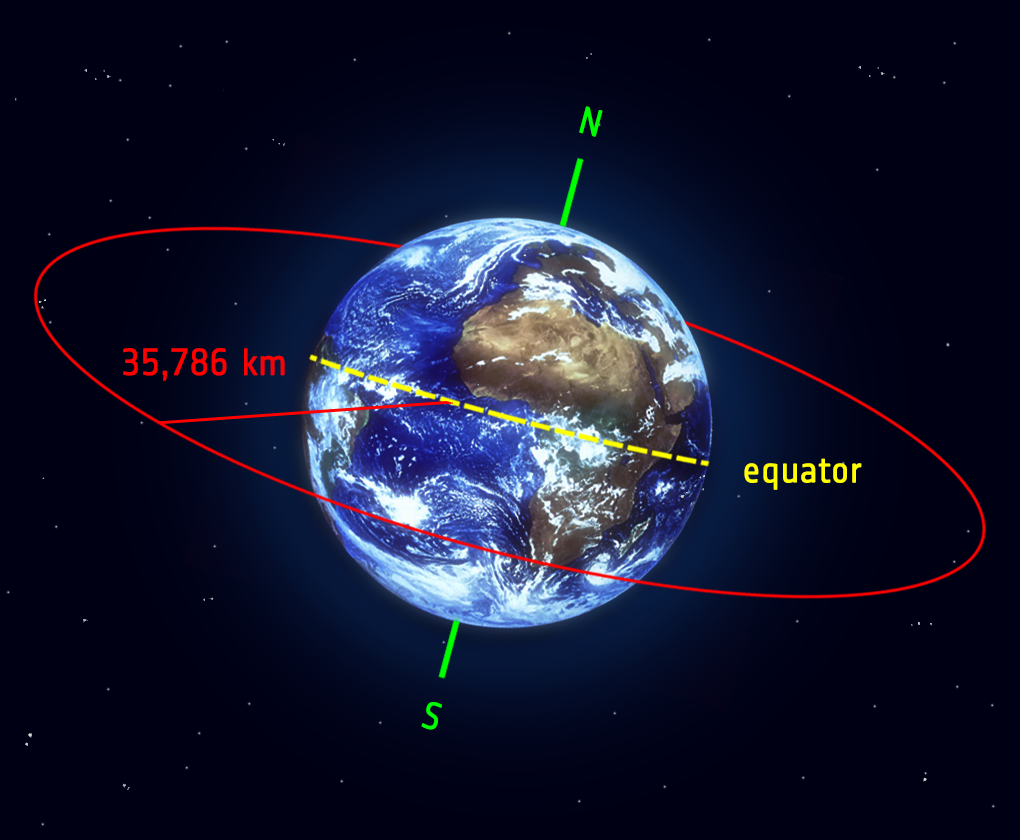
地球同步轨道(英语:Geosynchronous orbit,GSO),是一个以地球为中心的轨道。其轨道周期与地球自转周期一致,为23小时56分4秒(一个恒星日)。
地球同步轨道的一个特例是地球静止轨道,它是地球赤道平面上的一个圆形地球同步轨道。在地球静止轨道上的卫星对地面上的观察者来说,在天空中的位置保持不变。
通讯卫星通常采用地球静止轨道或接近地球静止轨道,这样与之通信的卫星天线就不必移动,而是可以永久地指向天空中卫星出现的固定位置。
根据中国航天科技集团资料,地球同步轨道的轨道高度为35788千米。
Eine geosynchrone Umlaufbahn ist ein Satellitenorbit, bei dem die Umlaufzeit um die Erde mit der Rotationsdauer der Erde (siderischer Tag) exakt übereinstimmt; der Satellit umkreist also die Erde zwar insgesamt synchron zur Erddrehung, jedoch nicht unbedingt synchron zu jedem Zeitpunkt. Da die Synchronizität nicht unbedingt für jeden Zeitpunkt des Umlaufs gilt, kann für einen Beobachter auf der Erdoberfläche der Satellit mit Exzentrizitäten ≠ 0 zeitweise seitlich vor- oder nachlaufen und für Bahnneigungen ≠ 0° auf- oder absteigen. Im speziellen Fall der geostationären Umlaufbahn (Bahnneigung = 0° und Exzentrizität = 0) steht ein Satellit für den Beobachter hingegen immer am selben Punkt am Himmel.
Da Vor- und Nachlauf und Auf- und Abbewegung sehr empfindlich auf Störungen der Bahnneigung und Exzentrizität reagieren, fallen Bahnstörungen hervorgerufen durch gravitative Einflüsse von Sonne und Mond und durch die Anisotropie des Gravitationsfeldes der Erde bei geostationären Umlaufbahnen besonders auf. Geostationär positionierte Satelliten benötigen fast ständig Treibstoff, um die Bahnstörungen zu korrigieren. Allein dadurch haben sie nur eine begrenzte Lebensdauer. Bei geosynchronen Umlaufbahnen hingegen sind die dadurch verursachten Bewegungen „Teil des Systems“, da die Empfänger auf der Erdoberfläche darauf eingestellt sind, dass sich Satelliten mit (nur) geosynchroner (aber nicht auch geostationärer) Umlaufbahn in einem Definierten und bekannten Bereich bewegen.
Einsatzzwecke geosynchoner (und v. a. geostationärer) Satelliten liegen hauptsächlich im Bereich der fix installierten Kommunikation, aber auch Wettersatelliten nutzen die Vorteile dieses Orbits. Für die Nutzung von geosynchronen Satelliten kann die Empfangsantenne auf der Erdoberfläche der jeweiligen Position des Satelliten angepasst werden, was bodenseitig zwar den technischen Aufwand erhöht, aber die Satellitenlebensdauer verlängert.

盖亚任务(Gaia)是欧洲空间局(ESA)的空间望远镜[4]。本任务的目的是要绘制一个包含约10亿颗或银河系1%恒星的三维星图[5][6][7]。作为依巴谷卫星的后继任务,盖亚任务是 ESA 在2000年以后的远期科学任务。盖亚任务在约5年的任务中将可观测到视星等最暗为20等的天体。它的目标包含:
- 确认10亿颗恒星的位置、距离和每年自行运动量。对视星等15等恒星的精确度为20 µas,20等则为200 µas。
- 侦测数万个太阳系外行星系统[8]。
- 能够发现轨道在地球和太阳之间的阿波希利型小行星。这个区域对地面望远镜相当难以观测,因为该区域几乎只在白昼时才会出现在天球[9]。
- 侦测最多50万个类星体。
- 阿尔伯特·爱因斯坦广义相对论的更精确实验。
盖亚任务的资料将可建立在银河系内甚至之外的极高分辨率三维星图,并且绘出恒星的运动方向以了解银河系的形成与演化。分光光度法量测可以得知被观测恒星的物理性质,以确认其光度、有效温度、表面重力和组成元素。这种大规模的恒星观测将提供许多基本观测资料以解决关于银河系形成、结构与演化等多种重要问题。大量的类星体、星系、太阳系外行星和太阳系天体也将同时被观测。
亚利安航太公司(Arianespace SA)预计将于2013年12月[10]在圭亚那太空中心使用联盟号运载火箭为 ESA 发射盖亚空间望远镜[11]。该卫星将在地球轨道的 L2 拉格朗日点附近以利萨如轨道运行。
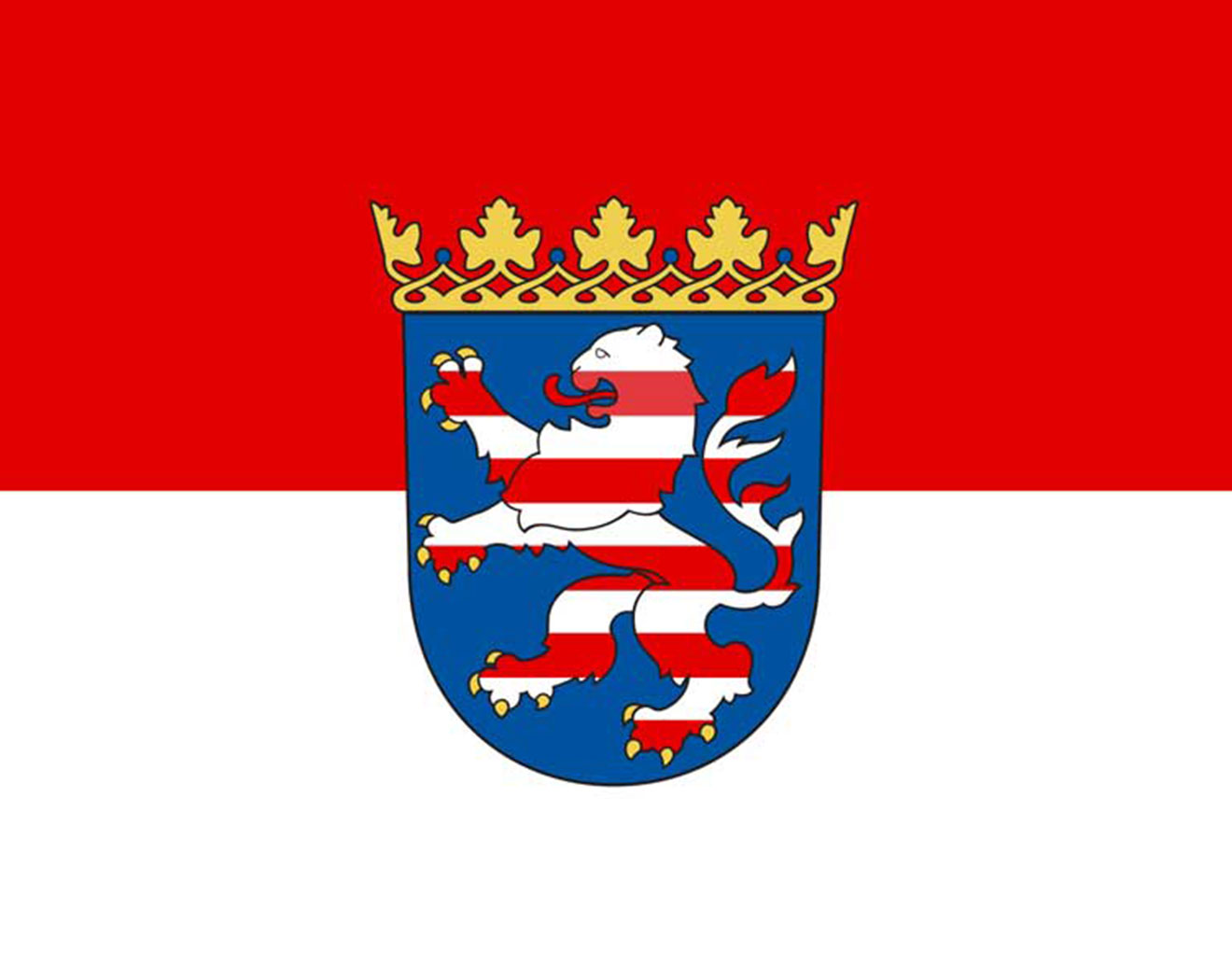 Hessen
Hessen
 Madrid
Madrid
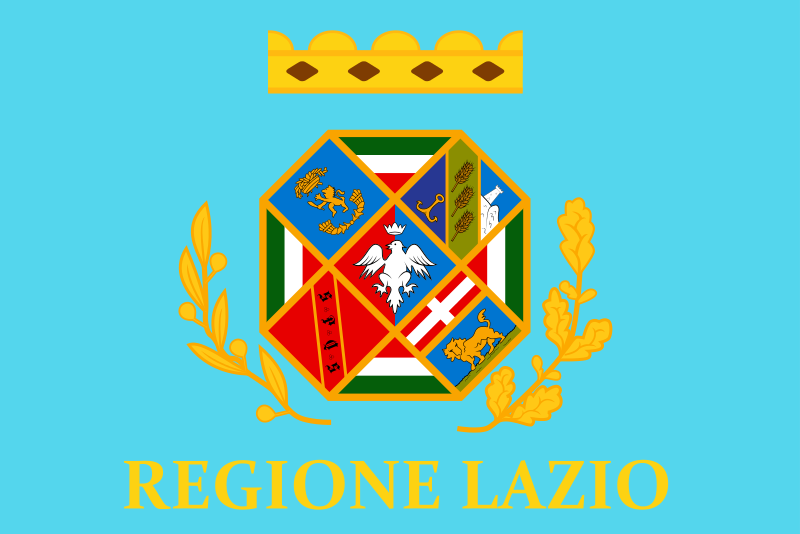 Lazio
Lazio
